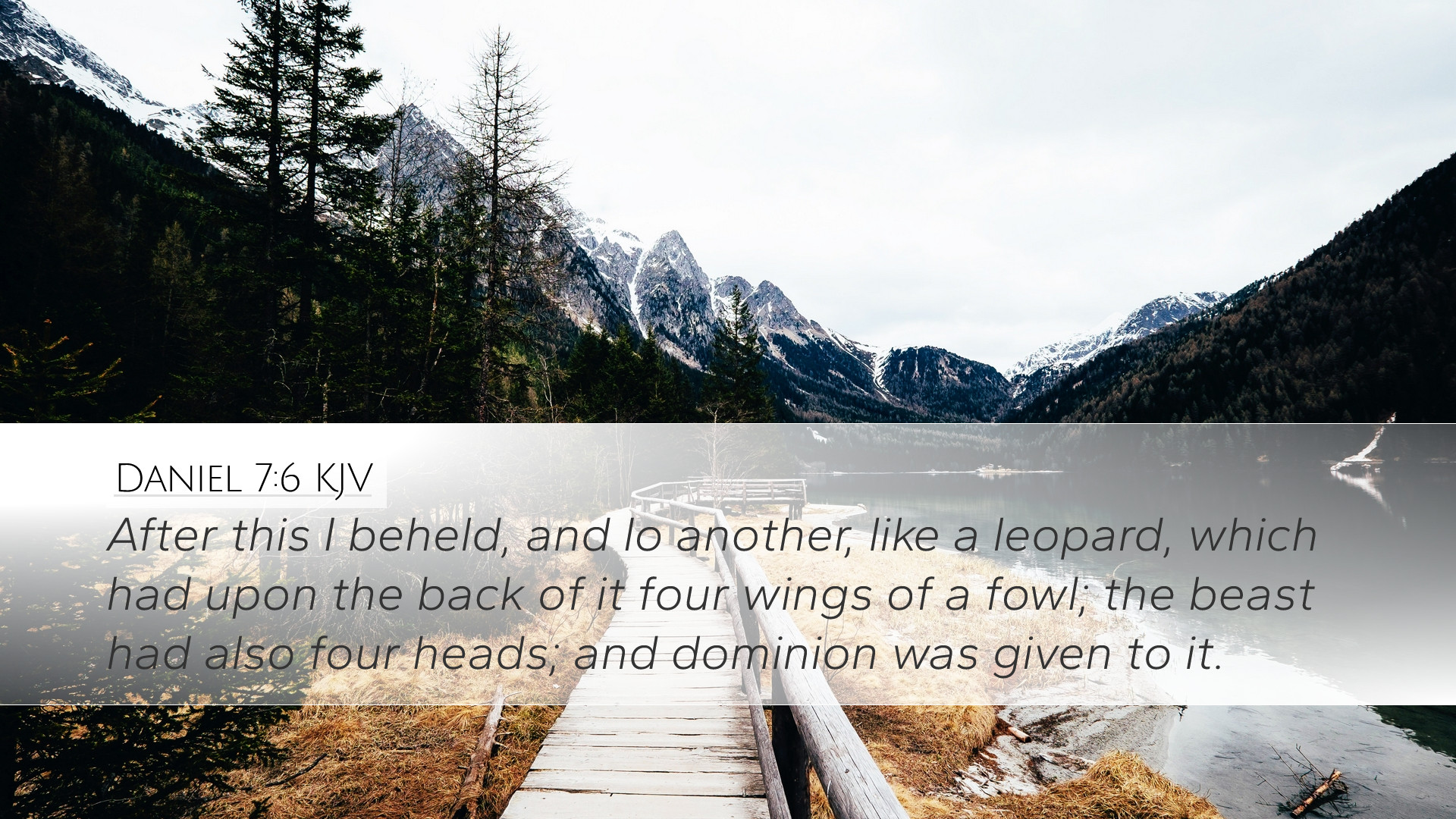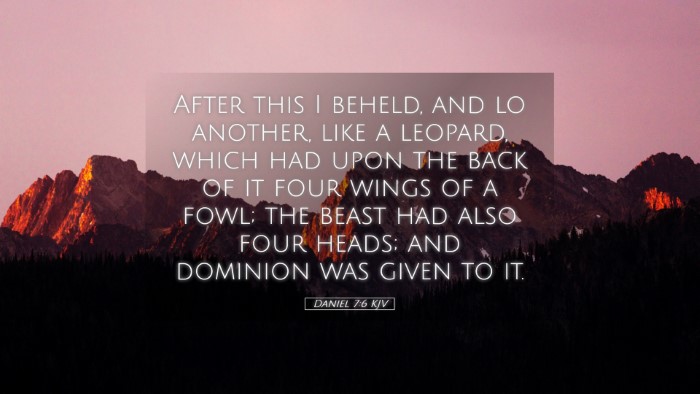Commentary on Daniel 7:6
Daniel 7:6 presents a vivid depiction of a beast that resonates with themes of power, dominion, and the unfolding of God's sovereignty over the kingdoms of the earth. This verse is part of Daniel's prophetic vision, wherein he encounters a series of beasts that symbolize various nations and empires. In this commentary, we draw on insights from notable public domain commentaries, including those by Matthew Henry, Albert Barnes, and Adam Clarke, to offer a comprehensive understanding of this verse.
The Text of Daniel 7:6
"After this I looked, and behold, another, like a leopard, which had upon the back of it four wings of a fowl; the beast had also four heads; and dominion was given to it."
Contextual Overview
Daniel 7 contains a series of prophetic visions that provide insights into the succession of empires leading up to the establishment of God's eternal kingdom. In contrast to the statue in Daniel 2, the beasts in this chapter do not represent human stature but rather highlight the brutal and beastly nature of the empires that oppress God's people.
Insights from Matthew Henry
Matthew Henry emphasizes that the vision of the beasts reveals the nature of earthly kingdoms as beast-like, suggesting that the kingdoms of this world often exhibit characteristics of ferocity and self-serving dominion. Specifically concerning the leopard:
- Speed and Agility: The leopard is symbolic of the rapidity of conquests, underscored by the four wings, representing swiftness in achieving power.
- Multiple Heads: The four heads might indicate a division of authority or a multiplicity of ruling powers within one empire, hinting at internal divisions leading to broader dominion.
- Sovereignty Granted: The phrase "dominion was given to it" suggests that this power is not innate but is permitted by God, underscoring the theological theme of divine sovereignty over human governance.
Insights from Albert Barnes
Albert Barnes offers a detailed elucidation regarding the symbolisms encapsulated in the leopard beast. He articulates that:
- Historical Context: The leopard is often correlated with the Greek Empire, particularly under Alexander the Great, known for his swift conquests and military prowess.
- Examination of the Heads: Referring to the four heads, Barnes posits that this may represent the four principal divisions of the Greek Empire following Alexander's death, as it was divided among his generals (the Diadochi).
- God's Sovereignty: Barnes reiterates the importance of acknowledging God's control over the rise and fall of these empires, thus inviting readers to trust in God's ultimate plan amidst human history.
Insights from Adam Clarke
Adam Clarke brings attention to the prophetic implications of Daniel's vision. He notes the significance of the leopard's characteristics:
- Leopards as Predators: Clarke emphasizes the ferocity and predatory nature of leopards, which parallels the oppressive nature of the empires described in the visions.
- The Symbol of Wings: The four wings symbolize extraordinary speed and aggression, traits that denote a rapid rise to power, reinforcing the idea of quick and forceful dominion over territories.
- Four Heads Symbolizing Authority: Clarke suggests that the multiple heads may indicate not just four rulers, but they could symbolize the continuity and complexity of governance even within a singular empire.
Theological Implications
Daniel 7:6 invites robust theological reflection, particularly in its affirmation of God's sovereignty over the powers of the earth:
- God's Sovereign Will: The verse illustrates how God ordains the progress of history, allowing empires to rise and fall while maintaining control over the ultimate narrative of salvation and judgment.
- The Reality of Evil Empires: The portrayal of beastly kingdoms serves as a stark reminder of the nature of earthly powers that often seek to subjugate God’s people.
- Encouragement for the Faithful: For pastors and scholars, this passage becomes an assurance that despite appearances, God's kingdom endures. Christians are encouraged to remain steadfast in faith, knowing that the reign of God will ultimately surpass all earthly dominions.
Conclusion
Daniel 7:6 serves as a critical verse for understanding the dynamics of power and the overarching providence of God in history. Engaging with insights from recognized commentators allows for a richer interpretation, guiding pastors, students, theologians, and scholars in their study and proclamation of Scripture. The imagery of the leopard with its four wings and heads is a poignant reminder of the transient nature of earthly kingdoms contrasted with the everlasting kingdom of God.


